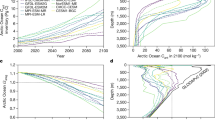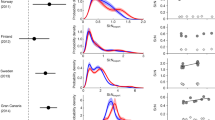Abstract
Today's surface ocean is saturated with respect to calcium carbonate, but increasing atmospheric carbon dioxide concentrations are reducing ocean pH and carbonate ion concentrations, and thus the level of calcium carbonate saturation. Experimental evidence suggests that if these trends continue, key marine organisms—such as corals and some plankton—will have difficulty maintaining their external calcium carbonate skeletons. Here we use 13 models of the ocean–carbon cycle to assess calcium carbonate saturation under the IS92a ‘business-as-usual’ scenario for future emissions of anthropogenic carbon dioxide. In our projections, Southern Ocean surface waters will begin to become undersaturated with respect to aragonite, a metastable form of calcium carbonate, by the year 2050. By 2100, this undersaturation could extend throughout the entire Southern Ocean and into the subarctic Pacific Ocean. When live pteropods were exposed to our predicted level of undersaturation during a two-day shipboard experiment, their aragonite shells showed notable dissolution. Our findings indicate that conditions detrimental to high-latitude ecosystems could develop within decades, not centuries as suggested previously.
This is a preview of subscription content, access via your institution
Access options
Subscribe to this journal
Receive 51 print issues and online access
$199.00 per year
only $3.90 per issue
Buy this article
- Purchase on Springer Link
- Instant access to full article PDF
Prices may be subject to local taxes which are calculated during checkout






Similar content being viewed by others
References
Haugan, P. M. & Drange, H. Effects of CO2 on the ocean environment. Energy Convers. Mgmt 37, 1019–1022 (1996)
Brewer, P. G. Ocean chemistry of the fossil fuel CO2 signal: the haline signal of “business as usual”. Geophys. Res. Lett. 24, 1367–1369 (1997)
Gattuso, J.-P., Frankignoulle, M., Bourge, I., Romaine, S. & Buddemeier, R. W. Effect of calcium carbonate saturation of seawater on coral calcification. Glob. Planet. Change 18, 37–46 (1998)
Kleypas, J. A. et al. Geochemical consequences of increased atmospheric carbon dioxide on coral reefs. Science 284, 118–120 (1999)
Langdon, C. et al. Effect of elevated CO2 on the community metabolism of an experimental coral reef. Glob. Biogeochem. Cycles 17, 1011, doi:10.1029/2002GB001941 (2003)
Riebesell, U. et al. Reduced calcification of marine plankton in response to increased atmospheric CO2 . Nature 407, 364–367 (2000)
Zondervan, I., Zeebe, R., Rost, B. & Riebesell, U. Decreasing marine biogenic calcification: A negative feedback on rising atmospheric pCO2 . Glob. Biogeochem. Cycles 15, 507–516 (2001)
Broecker, W. S. & Peng, T.-H. Fate of fossil fuel carbon dioxide and the global carbon budget. Science 206, 409–418 (1979)
Feely, R. A. et al. The impact of anthropogenic CO2 on the CaCO3 system in the oceans. Science 305, 362–366 (2004)
Caldeira, K. & Wickett, M. E. Anthropogenic carbon and ocean pH. Nature 425, 365 (2003)
Urban-Rich, J., Dagg, M. & Peterson, J. Copepod grazing on phytoplankton in the Pacific sector of the Antarctic Polar Front. Deep-Sea Res. II 48, 4223–4246 (2001)
Kobayashi, H. A. Growth cycle and related vertical distribution of the thecosomatous pteropod Spiratella “Limacina” helicina in the central Arctic Ocean. Mar. Biol. 26, 295–301 (1974)
Pakhomov, E. A., Verheye, H. M., Atkinson, A., Laubscher, R. K. & Taunton-Clark, J. Structure and grazing impact of the mesozooplankton community during late summer 1994 near South Georgia, Antarctica. Polar Biol. 18, 180–192 (1997)
Fabry, V. J. Aragonite production by pteropod molluscs in the subarctic Pacific. Deep-Sea Res. I 36, 1735–1751 (1989)
Bathmann, U., Noji, T. T. & von Bodungen, B. Sedimentation of pteropods in the Norwegian Sea in autumn. Deep-Sea Res. 38, 1341–1360 (1991)
Key, R. M. et al. A global ocean carbon climatology: Results from Global Data Analysis Project (GLODAP). Glob. Biogeochem. Cycles 18, 4031, doi:10.1029/2004GB002247 (2004)
Sabine, C. L. et al. The ocean sink for anthropogenic CO2 . Science 305, 367–370 (2004)
Gruber, N. Anthropogenic CO2 in the Atlantic Ocean. Glob. Biogeochem. Cycles 12, 165–191 (1998)
Sarmiento, J. L., Orr, J. C. & Siegenthaler, U. A perturbation simulation of CO2 uptake in an ocean general circulation model. J. Geophys. Res. 97, 3621–3645 (1992)
Orr, J. C. et al. Estimates of anthropogenic carbon uptake from four three-dimensional global ocean models. Glob. Biogeochem. Cycles 15, 43–60 (2001)
Kalnay, E. et al. The NCEP/NCAR 40-year reanalysis project. Bull. Am. Meteorol. Soc. 77, 437–471 (1996)
Feely, R. A. et al. Winter–summer variations of calcite and aragonite saturation in the northeast Pacific. Mar. Chem. 25, 227–241 (1988)
Feely, R. A., Byrne, R. H., Betzer, P. R., Gendron, J. F. & Acker, J. G. Factors influencing the degree of saturation of the surface and intermediate waters of the North Pacific Ocean with respect to aragonite. J. Geophys. Res. 89, 10631–10640 (1984)
Sarmiento, J. L. et al. Response of ocean ecosystems to climate warming. Glob. Biogeochem. Cycles 18, 3003, doi:10.1029/2003GB002134 (2004)
Bopp, L. et al. Potential impact of climate change of marine export production. Glob. Biogeochem. Cycles 15, 81–99 (2001)
Sarmiento, J. L., Le Quéré, C. & Pacala, S. Limiting future atmospheric carbon dioxide. Glob. Biogeochem. Cycles 9, 121–137 (1995)
Heinze, C. Simulating oceanic CaCO3 export production in the greenhouse. Geophys. Res. Lett. 31, L16308, doi:10.1029/2004GL020613 (2004)
Iglesias-Rodriguez, M. D. et al. Representing key phytoplankton functional groups in ocean carbon cycle models: Coccolithophorids. Glob. Biogeochem. Cycles 16, 1100, doi:10.1029/2001GB001454 (2002)
Berner, R. A. in The Fate of Fossil Fuel CO2 in the Oceans (eds Andersen, N. R. & Malahoff, A.) 243–260 (Plenum, New York, 1977)
Fabry, V. J. Shell growth rates of pteropod and heteropod molluscs and aragonite production in the open ocean: Implications for the marine carbonate system. J. Mar. Res. 48, 209–222 (1990)
Bé, A. W. H. & Gilmer, R. W. Oceanic Micropaleontology Vol. 1 (ed. Ramsey, A.) 733–808 (Academic, London, 1977)
Dadon, J. R. & de Cidre, L. L. The reproductive cycle of the Thecosomatous pteropod Limacina retroversa in the western South Atlantic. Mar. Biol. 114, 439–442 (1992)
Seibel, B. A. & Dierssen, H. M. Cascading trophic impacts of reduced biomass in the Ross Sea, Antarctica: Just the tip of the iceberg? Biol. Bull. 205, 93–97 (2003)
Accornero, A., Manno, C., Esposito, F. & Gambi, M. C. The vertical flux of particulate matter in the polyna of Terra Nova Bay. Part II. Biological components. Antarct. Sci. 15, 175–188 (2003)
Collier, R., Dymond, J., Susumu Honjo, S. M., Francois, R. & Dunbar, R. The vertical flux of biogenic and lithogenic material in the Ross Sea: moored sediment trap observations 1996–1998. Deep-Sea Res. II 47, 3491–3520 (2000)
Honjo, S., Francois, R., Manganini, S., Dymond, J. & Collier, R. Particle fluxes to the interior of the Southern Ocean in the western Pacific sector along 170° W. Deep-Sea Res. II 47, 3521–3548 (2000)
Betzer, P. R., Byrne, R., Acker, J., Lewis, C. S. & Jolley, R. R. The oceanic carbonate system: a reassessment of biogenic controls. Science 226, 1074–1077 (1984)
Byrne, R. H., Acker, J. G., Betzer, P. R., Feely, R. A. & Cates, M. H. Water column dissolution of aragonite in the Pacific Ocean. Nature 312, 321–326 (1984)
Lalli, C. M. Structure and function of the buccal apparatus of Clione limacina (Phipps) with a review of feeding in gymnosomatous pteropods. J. Exp. Mar. Biol. Ecol. 4, 101–118 (1970)
Foster, B. A. & Montgomery, J. C. Planktivory in benthic nototheniid fish in McMurdo Sound, Antarctica. Environ. Biol. Fish. 36, 313–318 (1993)
Pakhomov, E., Perissinotto, A. & McQuaid, C. D. Prey composition and daily rations of myctophid fishes in the Southern Ocean. Mar. Ecol. Prog. Ser. 134, 1–14 (1996)
La Mesa, M., Vacchi, M. & Sertorio, T. Z. Feeding plasticity of Trematomus newnesi (Pisces, Nototheniidae) in Terra Nova Bay, Ross Sea, in relation to environmental conditions. Polar Biol. 23, 38–45 (2000)
Willette, T. M. et al. Ecological processes influencing mortality of juvenile pink salmon (Oncorhynchus gorbuscha) in Prince William Sound, Alaska. Fish. Oceanogr. 10, 14–41 (2001)
Boldt, J. L. & Haldorson, L. J. Seasonal and geographical variation in juvenile pink salmon diets in the Northern Gulf of Alaska and Prince William Sound. Trans. Am. Fisheries Soc. 132, 1035–1052 (2003)
Lalli, C. M. & Gilmer, R. Pelagic Snails (Stanford Univ. Press, Stanford, 1989)
Freiwald, A., Fosså, J. H., Grehan, A., Koslow, T. & Roberts, J. M. Cold-water Coral Reefs: Out of Sight—No Longer Out of Mind (No. 22 in Biodiversity Series, UNEP-WCMC, Cambridge, UK, 2004)
Dayton, P. K. in Polar Oceanography, Part B: Chemistry, Biology and Geology (ed. Smith, W. O.) 631–685 (Academic, San Diego, 1990)
Shirayama, Y. & Thornton, H. Effect of increased atmospheric CO2 on shallow-water marine benthos. J. Geophys. Res. 110, C09S09, doi:10.1029/2004JC002561 (2005)
Petit, J. R. et al. Climate and atmospheric history of the past 420,000 years from the Vostok ice core, Antarctica. Nature 399, 429–436 (1999)
Pearson, P. N. & Palmer, M. R. Middle Eocene seawater pH and atmospheric carbon dioxide concentrations. Science 284, 1824–1826 (1999)
Acknowledgements
We thank M. Gehlen for discussions, and J.-M. Epitalon, P. Brockmann and the Ferret developers for help with analysis. All but the climate simulations were made as part of the OCMIP project, which was launched in 1995 by the Global Analysis, Integration and Modelling (GAIM) Task Force of the International Geosphere–Biosphere Programme (IGBP) with funding from NASA (National Aeronautics and Space Administration). OCMIP-2 was supported by the European Union Global Ocean Storage of Anthropogenic Carbon (EU GOSAC) project and the United States JGOFS Synthesis and Modeling Project funded through NASA. The interannual simulation was supported by the EU Northern Ocean Carbon Exchange Study (NOCES) project, which is part of OCMIP-3.
Author information
Authors and Affiliations
Corresponding author
Ethics declarations
Competing interests
Reprints and permissions information is available at npg.nature.com/reprintsandpermissions. The authors declare no competing financial interests.
Supplementary information
Supplementary Notes
Supplementary Methods, uncertainties, Supplementary Table, Supplementary Figures S1–S5 and additional references (PDF 2126 kb)
Rights and permissions
About this article
Cite this article
Orr, J., Fabry, V., Aumont, O. et al. Anthropogenic ocean acidification over the twenty-first century and its impact on calcifying organisms. Nature 437, 681–686 (2005). https://doi.org/10.1038/nature04095
Received:
Accepted:
Issue Date:
DOI: https://doi.org/10.1038/nature04095
This article is cited by
-
Severe 21st-century ocean acidification in Antarctic Marine Protected Areas
Nature Communications (2024)
-
Cross-shore transport and eddies promote large scale response to urban eutrophication
Scientific Reports (2024)
-
Contrasting patterns in pH variability in the Arabian Sea and Bay of Bengal
Environmental Science and Pollution Research (2024)
-
Infaunal invertebrate community relationships to water column and sediment abiotic conditions
Marine Biology (2024)
-
Short-term responses of Corallina officinalis (rhodophyta) to global-change drivers in a stressful environment of Patagonia, Argentina
Marine Biology (2024)
Comments
By submitting a comment you agree to abide by our Terms and Community Guidelines. If you find something abusive or that does not comply with our terms or guidelines please flag it as inappropriate.



